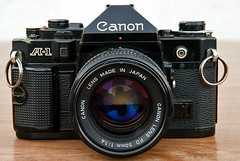Canon A-1

|
| Canon A-1 with 50mm f/1.4 lens |
The A-1 was a 35mm SLR made by Canon in Japan. The popularity of today's high-tech circuitry in cameras has much to owe to the A-1. Introduced in 1978, this camera has remained the ultimate reference camera in many minds for over a quarter of a century.
The A-1 was among the first cameras to be completely dependant on battery power, and that fact would prove to be an asset in light of the dramatically improved accuracy and ease of use. This power came from a 6v PX28 battery, or 4 LR44 1.5v alkaline cells, kept in a battery compartment on the front, partly hidden by a screwed-on finger grip (the "Action Grip"[1]).
The A-1 was was fitted with the Canon FD bayonet lens mount and was normally sold with the Canon FD 50mm f/1.8 standard lens, or the excellent 50mm f/1.4. Unlike most other Canon SLRs, the A-1 was only available in black, not chrome finish.
Features
The A-1 had the choice of aperture- or shutter-priority automatic exposure, the first [2] "programmed" fully-auto mode, as well as automatic dedicated flash, and a fully manual setting. There was a numerical display in the viewfinder of shutter and aperture, using red LED seven-segment displays. To avoid fogging from the viewfinder on long exposures, the LED display could be switched off, and the eyepiece closed off with a shutter.
The settings dial is shown (right) set to shutter-priority auto ("Tv"). The programmed setting (marked [P] in a green square) is just past the 1/1000 mark. Rotating the collar around the shutter-release to "Av" sets aperture-priority and changes the scale from speed (black background) to aperture settings (on a yellow background). Speeds (manual or auto), or apertures (in auto mode) are adjusted by a wheel in front of the dial; the users right index finger naturally falls on this. There was a sliding cover for the wheel, so the user could prevent accidental changes to settings.

|
| A-1 settings dial |
For automatic operation, the aperture ring of the lens was set to the "A" position; for manual settings, the required aperture was set on the lens and the shutter set on the dial, in the "Tv" position.
The electronically-controlled horizontal cloth focal plane shutter had marked speeds from 30s to 1/1000s, with X-sync at 1/60. In aperture priority mode, the shutter was continuously variable.
Around the wind-on lever is the On (A)/ Off (L, lock)/ self-timer (2 or 10 sec) switch, and also a double-exposure release - allowing cocking the shutter without advancing the film {this is covered by the lever in the photo above}.
On the users left, on the front is a peculiar slider, with a flip-up finger pad, which is the stop-down lever for depth of field preview and stop-down metering. On the side of the lens mount are buttons for exposure preview, and exposure memory.

|
| Hot shoe with dedicated flash contacts |
Dedicated flashguns could be attached to the hot shoe, where there were two additional contacts for camera-gun communication. There was also a PC socket - on the front, near the rewind crank - for conventional flashguns.
Around the rewind crank is the speed setting dial, with ±2 stop exposure compensation adjustment.
The base of the A-1 has electrical contacts and a mechanical linkage for a motor drive, as well as the tripod bush and rewind release.
Two features missing from the A-1 are a mirror lock and bulb flash sync.
The A-1 has a cloth shutter, known to stick at times, and also known for the dreaded Canon squeal. It is not uncommon to see broken or taped battery doors on used models.
Notes
- ↑ named in the manual
- ↑ According to Canon, in their museum
Links
In English:
- Canon A-1 at Photography in Malaysia
- Canon A-1 and AV-1 at The Camera Site by Reijo Lauro
- A-1 in Canon's Museum
- Canon A1 Camera Manual : Photo-Manuals.com by Ben Squire
In French:
- Lionel's Canon A-1 overview at 35mm-compact.com
- Canon A-1 and French user manual at Sylvain Halgand's collection-appareils.fr
- Canon A-1 picture set at 'tochka Z on Flickr' by Patrick Verbessem